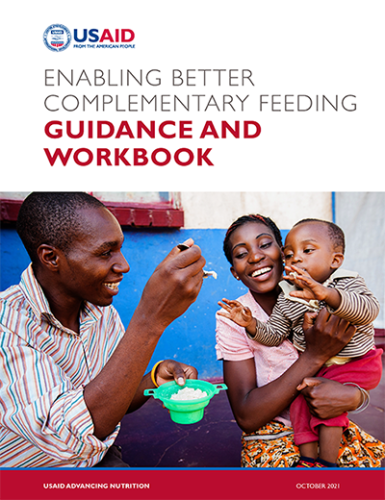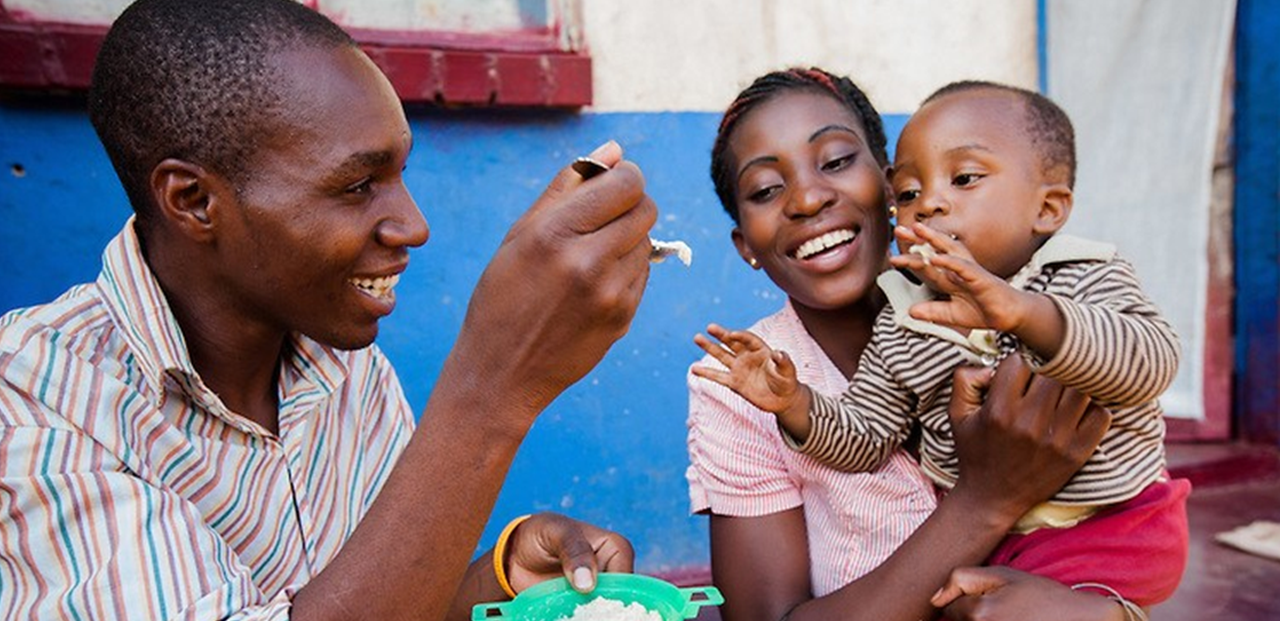Are you a program planner or practitioner working to improve complementary feeding of young children or other nutrition behaviors?
Use this web page to explore key concepts of behavior-centered programming to improve nutrition outcomes, with complementary feeding as your case study example. This page also introduces the six modules in the associated Enabling Better Complementary Feeding: Guidance and Workbook. Each module details a step-by-step social and behavior change (SBC) process that includes program examples and key considerations.
Check out materials from our related workshop series and summary webinar! Explore additional resources for complementary feeding focused on integrating nurturing care, optimizing young child diets, and complementary feeding in emergencies.

Have you already reviewed this guidance page? Are you ready to dig deeper into the specifics of programming?
If yes, jump directly to a module page. If no, keep scrolling to read the guidance!
Complementary Feeding Matters—A Lot!
The first years of a child’s life are critical for growth and healthy physical and cognitive development. From birth to 6 months, exclusive breastfeeding gives children ideal nutrition.
At 6 months of age, children are able to chew, swallow, and digest foods other than breast milk, which means they can start to eat complementary foods to meet their energy and nutrient requirements.
Why, what, how much, how often, and with what help a child should eat complementary foods must constantly evolve to meet his or her changing needs. And the complementary feeding period is an important time to establish positive feeding practices throughout the early years.
A Critical Time for Growth and Development
High nutrient needs
Children's nutrient requirements per kilogram of body weight are higher than for any other age group due to rapid growth and development and increased activity.
Limited intake per feeding
Despite these high nutrient needs, children are only able to ingest small amounts of food at one time due to stomach size.
Rapid change
The frequency, amount, and consistency of food that children need changes throughout the period.

Why Use SBC to Improve Complementary Feeding?
Behaviors are the roots of any nutrition program. A social and behavior change approach (SBC) is vital to improve complementary feeding because it puts people, and their behaviors, at the heart of problem-solving.
Behaviors are what we do. Whether caregivers, families, community or religious leaders, farmers, health workers, market vendors, or policymakers, we all practice different behaviors that can influence complementary feeding.
Why Use SBC to Improve Complementary Feeding?
Behaviors are the roots of any nutrition program. A social and behavior change approach (SBC) is vital to improve complementary feeding because it puts people, and their behaviors, at the heart of problem-solving.
Behaviors are what we do. Whether caregivers, families, community or religious leaders, farmers, health workers, market vendors, or policymakers, we all practice different behaviors that can influence complementary feeding.
Enabling optimal nutrition behaviors, including complementary feeding, starts with quality SBC during design; implementation; and monitoring, evaluation, and learning (MEL).
SBC is a systematic, evidence-driven approach to improve and sustain changes in behaviors, norms, and the enabling environment. SBC activities aim to affect key behaviors and social norms by addressing their individual, social, and structural determinants (factors). The role of human behavior is fundamental to the success of all development programs, thus, SBC is central to achieving many of USAID’s program outcomes.

Quality SBC involves multiple sectors—from health to food systems to early childhood development—and touches on the behaviors of people within those sectors.
Quality SBC involves multiple sectors—from health to food systems to early childhood development—and touches on the behaviors of people within those sectors.
Quality SBC approaches can support adequate foods, services, and practices for complementary feeding
While the role of SBC in adequate feeding practices is well recognized, quality SBC processes are equally important for ensuring adequate food and services for complementary feeding. SBC can support complementary feeding through—
- facilitating the adoption of feeding practices
- informing approaches to make safe, affordable, and diverse foods available and accessible
- improving provision of services to strengthen knowledge and skills around complementary feeding, support household food security, and enable a sanitary environment for feeding.
For example, when adequate food requires changes in affordability, an SBC lens and approach can help programmers and policymakers identify alternative food, packaging, or sizing or find support for price reduction.
Complementary Feeding Is Complex
In 2021, The Lancet identified complementary feeding strategies to improve dietary intake as a major global gap and recommended activity at national and subnational levels. But complementary feeding is complex! Complementary feeding behaviors change with the child’s age and are influenced by multiple factors across households, communities, and systems.
Globally Recommended Complementary Feeding Behaviors
The U.S. Agency for International Development SBC Working Group recommends six complementary feeding behaviors that have been shown to reduce malnutrition, especially stunting and wasting, in young children 6–23 months of age.
Module Overview
Effective programs start by identifying a few specific behaviors that are most likely to achieve overall goals. Programs that try to change too many behaviors at once are less likely to bring about lasting change than those that focus on fewer behaviors (Packard 2018).
- Identify specific behaviors.
- Prioritize behaviors.
Unlike health and nutrition services that involve a simple recommended practice such as handwashing, there is no one perfect way to feed a child. There are many possible ways to achieve positive outcomes, based on the interplay between individuals, the family, and the food environment. Formative research can reveal local solutions.
This module will help you:
- Look for existing research on the behaviors you prioritized in Module 1.
- Conduct additional research if you do not know the factors that prevent or support specific behaviors for each group of interest.
- Identify specific behaviors that caregivers are willing and able to cry out and assess how they might perform those behaviors in the context of their family and community systems.
An SBC strategy serves as a roadmap to chart the behaviors that the project aims to change, why those behaviors are prioritized, how the project addresses influencing factors, and expected results. It draws intentional pathways between priority behaviors and strategic activities. This approach helps address the factors that prevent or support the behaviors in a specific context.
This module will help you:
- Use a behavior profile to analyze each priority behavior.
- Collect and summarize the assessment of each priority behavior for inclusion in an SBC strategy.
- Collaborate and coordinate with stakeholders to review and refine the SBC strategy.
To put the SBC strategy into action, prepare an implementation plan that follows the project theory of change or results framework. If the plan for complementary feeding activities is part of a broader multi-sectoral project implementation plan, integrate complementary feeding activities with other planned activities.
This module will help you:
- Break each activity into realistic steps that carefully sequence needed inputs before promoting behaviors.
- Ensure that activities are specific enough to reach each type of participant group or audience.
- Develop activity plans, such as a communication plan, to detail essential elements.
- Build a MEL plan that lists the outputs, outcomes, and impact and guides monitoring efforts.
Implement the plan you developed in Module 4. Explicit attention to quality is essential to successfully implement SBC that improves complementary feeding.
This module will help you:
- Bring sector experts together for initial training and periodic reflections.
- Strengthen staff capacity through ongoing quality improvement, retraining, and coaching.
- Monitor implementation every three to six months through rapid surveys, review of program records, and qualitative feedback.
Program planning is the best time to think about evaluation. By determining what a program should achieve within a certain period, teams can plan activities with efficiency and effectiveness. Evaluations are opportunities to find out how complementary feeding behaviors have changed and determine which program and environmental factors contributed to those changes.
This module will help you:
- Think about key considerations for planning and designing an evaluation.
- Identify evaluation questions to ask.
- Determine which methods to use to conduct the evaluation and the type of experts you should have on your evaluation team.
- Think about how to share evaluation findings at the local, national, and global levels.
